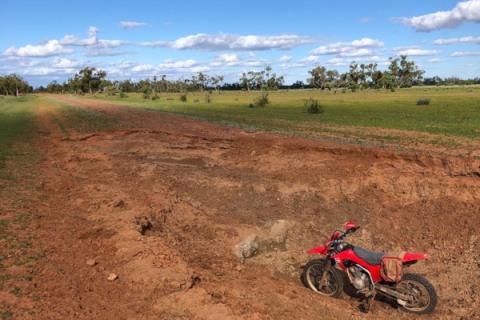It’s been a wet start to the year across parts of western NSW, with floodwater continuing to flow south from major rainfall events in Queensland’s south-west and our state’s north.
At Rathgar Station, located at Yantabulla, west of Bourke, the wet follows more than 12 months of below-average local rainfall and the widespread inundation, on a scale not seen in decades, is presenting both challenges and exciting opportunities for ecological renewal across the newly signed 4,068-hectare conservation area.
Landholder Mick Fisher described the water flows as “exceptional”, exceeding historic floods of 1974 and 1990.
“In late March, we received about 4 to 5 inches of localised rain, which was very welcome after a dry year,” he said.
“But the real impact came from further afield. Rainfall in distant catchments, up to 400kms away, caused major river systems to overflow and combine in ways we’d never seen before.”

Mick said the Paroo River doesn’t normally breach its banks in any significant way, but this time, the readings from Eulo, and upstream, signaled an unusual event was on its way south.
Wombah Lakes spilled on April 3, sending water into the Brindingabba Creek system, which flooded much of the Rathgar Station conservation area between April 8 and 10. The floodwaters connected with the Cuttaburra Creek, and more widespread inundation.
Using his Cessna 172 aircraft to monitor the situation, Mick said his team worked quickly to move livestock on the property and assess the unfolding situation.
“It moved fast. We were shocked at where the water reached. It’s certainly been the biggest flood we’ve seen since the ‘90s.”
Despite the challenges, Mick’s optimistic about water moving over the conservation area, and the biodiversity gains it could bring.
“Nature’s gift of water will have a long-lasting impact on the landscape,” he said.
“We expect to see a strong response across the area. There’s already regrowth, including golden goosefoot, cane grass, nutgrass and native acacias, and we’re hopeful for a return of birdlife and a revitalised ecosystem heading into spring.”
Mick also said his access to parts of the conversation area were still restricted but was looking forward to getting into these areas by late winter to see what changes had occurred.
Regional Manager Glenn Harpley said flooding events could be incredibly valuable for ecosystems.
“When floodplains in north-west NSW run with water, the nutrients they deliver can rejuvenate food chains and bring dormant ecosystems back to life,” he said. “It’s also not uncommon to see a resurgence of water birds that haven’t been around for years.”
However, Glenn said the downside was that floods could also displace wildlife and damage habitats, putting pressure on surviving areas and creating competition for food and shelter.
He encouraged landholders to reach out to their regional NSW Biodiversity Conservation Trust officers for advice on managing short and long-term impacts from flood events.
“We’re here to support landholders through both the challenges and the opportunities that come with significant natural events like this one.”